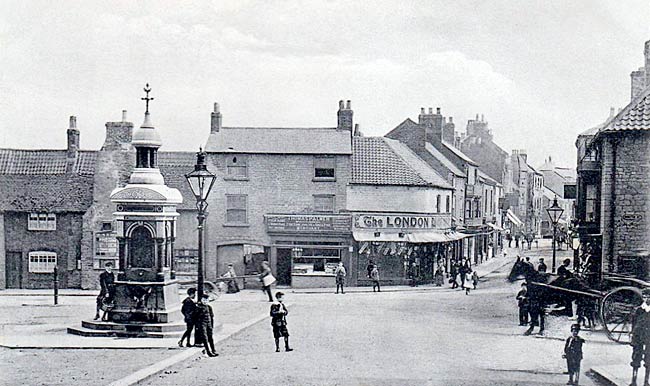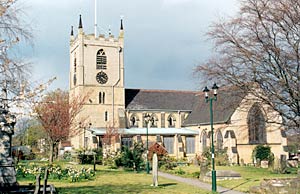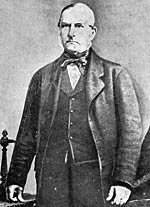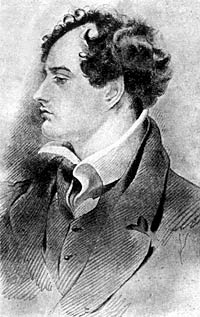< Previous | Contents | Next >
Here Byron Lies

Market Place and High Street, Hucknall, c.1910.
HUCKNALL. Its church has made this mining town a place of pilgrimage for over a hundred years, for here lies Byron, in a darkness made by stained glass windows. He lies with his mother and his only child under the chancel where some of his ancestors are buried, one of them the fifth Lord Byron (the Wicked Lord) who killed William Chaworth in a duel. The poet's bust is on the chancel wall, there are tributes to him from many famous men, a lovely lamp of beaten brass is for ever burning in his name, and in the chancel floor a wreath of leaves of brass is let into a stone sent by the King of Greece. The stone is part of the great block sent from Greece for the poet's statue in Hyde Park.
On this stone a little while before we called the Greek-Prime Minister, Venezilos, had laid a wreath of laurel leaves that he himself had gathered on the banks of the river Ilissus, the inscription paying a tribute of homage "to the immortal champion of Greece, on behalf of the Hellenic nation."
At Newstead, his ancestral home, are such relics of Byron as Nottingham has. There he lived at times in his schooldays, and became attached to the beautiful Mary Chaworth from whom he parted in the year before Trafalgar on Annesley Hill, the hill "crowned with a diadem of trees," of which he wrote,
Now no more, the hours beguiling,
Former favourite haunts I see,
Now no more my Mary smiling
Makes ye seem a heaven to me.

St Mary Magdalene, Hucknall, in 2002.
This church which hides itself in darkness (but happily redeems itself by enabling us to flood it with electric light) has 25 painted windows by Kempe, with 350 figures in them. It is good to see their shining jewels giving a touch of brightness in the twilight gloom. In the north transept is one window with four lights filled with scenes of the Nativity and the childhood of Jesus, rich with shepherds and kings, chalices and caskets, lanterns and trumpets. In the great east window is a scene in which Christ appears to the disciples on the road to Emmaus, and the face of one of the disciples suggests Lord Byron!
Two corners of the church have a bright light—the lady chapel 600 years old, which has been restored as a peace memorial to Hucknall's 260 heroes, and the baptistry with its 600-year-old font. It is said that one of the three bells in the tower was ringing when the font was new. The tower itself was raised to its present height in 1320, its lower part (with a beautiful wide arch, only slightly pointed) being all that is left of the simple church built at the close of Norman days. The nave and north aisle are 14th century, "the aisle windows and the clerestory are 15th. The south aisle and the transepts are additions of last century. The splendid timber-fronted porch has been here 600 years, and the stout oak door which was opened for Byron has been swinging on its hinges all the time. There are three stone coffin lids older still.
Two things Hucknall has from 16th and 17th century England, a sturdy chest with iron bands which has been recovered from a cowshed, and the lovely silver chalice given by Elizabeth Byron in 1664. One small possession it has from Jerusalem—a tiny cross made of glass mosaics, given by a Rabbi who received many kindnesses from the church, and said to have been in the floor of the Temple in the days of Our Lord. It is a thrilling fancy that if this is true Jesus may possibly have walked over them. There is some fine modern carving in wood and stone—stone corbels in the transepts, and on the chancel arch; wood panelling and screen work, carved figures on the pulpit, and an oak casket for holding the beautiful chalice. The reredos is a handsome gilded triptych.

Zachariah Green.
A painting of Christ and Mary Magdalene by Daniel Maclise, RA, hangs in the nave, which has other Bible scenes in mosaic. On the lower wall in the vestry is a brass tablet to Elijah West, who rang the bells and sang in the choir for 50 years; and in the churchyard are the graves of three men whose names are familiar to Hucknall folk. One is Canon Godber, who gave the mosaics and the 25 Kempe windows. Another is Zachariah Green, the old stocking-maker who lies in the shadow of a Japanese cherrytree which was enchanting with blossom when we called. He has also a granite fountain with his portrait in Titchfield Park, the inscription saying that "he was gifted with the art of healing and spent his life in alleviating the suffering of his fellow-men." The third grave is that of Ben Caunt, a boxer who met the famous Bendigo of Nottingham three times in combat, and was boxing champion of England in 1840.
By the aerodrome on the edge of the town is what is left of Bulwell Old Hall, once a home of the Byrons, who built it as a Dower House. For years it has been growing sad and forlorn, and a recent fire has left it a roofless shell. Most of its old woodwork is gone, but its famous spiral stairway is still here, each wide tread a solid piece of oak resting on the one beneath, all climbing round a central pillar.
Lord Byron's Last Journey

Lord Byron.
BYRON threw himself wholeheartedly into the Greek War of Independence, but the fever-ridden swamps of Missolonghi proved too much for his weakened constitution, and he died there on April 19, 1824. Throughout all Greece he was mourned as a benefactor and a true friend of the country.
His body was embalmed and for two days an unceasing stream of people passed through the church at Missolonghi to pay a last tribute. Byron had wished to be buried in England, and his remains were embarked on the Florida under a salute from the fortress guns, the guns which had welcomed him to Greece a few months before. In July the Florida anchored near London Bridge. Here the body was transferred to a lead coffin, and the heart and brain to an urn, to lie in state at Sir Edward Knatchbull's house at Westminster for two days before the hearse began its slow journey to Nottingham.
It was on this journey that by some dramatic chance Lady Caroline Lamb, the wife of Lord Melbourne, was suddenly confronted with the coffin of her old lover. She had been infatuated with him, though she wrote in her diary that he was mad, bad, and dangerous to know. After their quarrel her temper was so unmanageable that Lord Melbourne determined on a separation, but while the deed was waiting to be signed the two were reconciled and she met Byron no more. Now, ten years after, she turned her head on this summer's day and saw the funeral procession on its way to Newstead. It was a shock from which she never recovered. She was separated from her husband the next year, and died a few years later.
It was on July 16, three months after the poet's death, that the funeral procession left Nottingham for Hucknall, and one more remarkable incident is recorded of the funeral. We read that a man in the crowd was knocked into the mud and the only good clothes he had were spoiled; he was a minor poet whose name may be remembered perhaps as long as Byron's, poor John Clare.
Lord Broughton, Byron's friend and executor, and the last person to shake hands with him when he left England in 1816, described how the procession, a quarter of a mile long, wound its way through Papplewick and Linby, passing under Annesley Hill "crowned with the peculiar diadem of trees" immortalised by Byron, to reach this village church. The churchyard and the little church were so crowded that it was with difficulty that the mourners could follow the coffin up the aisle.
So the wayward genius was laid to his rest in the vault where his mother had been brought in 1811, and where he was followed in 1852 by his daughter, Augusta Ada, who is buried by his side.
